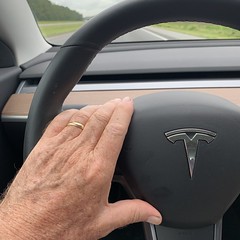Trust (but verify)
Self driving cars are a few years away. Letting Autopilot take control is like watching an inexperienced beginner on a learner permit. Fortunately, as a monitor (with skin at stake) you can gently intervene or abruptly take-over if the performance is not to one’s liking.
Current state of the art tech with Hardware 2.5 does quite the job centering the vehicle in the lane and maintaining proper distance from the car ahead with adaptive speed. Today, on an extended drive, I was able to sample test the latest enhancement: Navigate on Autopilot (beta) which further extends Autopilot.
Following GPS guidance Navigate on Autopilot suggests lane changes required for the route. Using cameras and forward radar it also recommends an open lane when overtaking a slower vehicle. You, as second pilot, acknowledge the suggestion and give permission with a tap on either stalk on the steering column (ignore is the default). In actuality you are babysitting the proceedings — and like a hawk.
There isn’t, nor should there be any trust expectation between you and the machine. The manufacturer (and his lawyer) feels the same way. Beyond any disclaimer you need to be attentive. The reason is called the automation hand-over. The autopilot can, after the briefest of warning, signal bailout and return control. If your head is not in the game this transfer could be messy. So, autopilot continually confirms that you are standing by. If you’re not detected actually holding the steering wheel you are politely prodded before it becomes serious. The system shuts off / locks out an abuser ignoring any cautionary nags.

The autosteer function continually saws back and forth ever so minutely seemingly testing to see that it has not been abandoned. A sensitive passenger may perceive the motion but in comparison to earlier iterations it is fairly smooth going.
Hardware 1.0 was primitive as autosteer would ping pong on secondary roadways hugging the inside line or wandering inebriated opposite. Still, it was exciting to experience this alpha software. Realizing that the future had arrived inspired anticipation for FSD
Lane keeping on today’s trip was quite good during the Interstate portion. There were some, shades of yore, one spurious blip of regen, a wander noted in the tight radii of an exit ramp. A little faith was required but no boundaries were exceeded. I did wonder what any closely following driver might be thinking.
whoa boy (too wild)
This happened… A mowing tractor pedaling the shoulder as fast as he could go — hazard flashers blinking but protruding somewhat into the right lane. Autopilot decelerated for the detected obstacle as it should do. I switched off auto steering and moved to the left lane to pass which was occupied by a truck just ahead. During the maneuver, just as I started over Autopilot saw daylight between Mower and Truck and (adaptive cruise control still engaged) accelerated harshly. Splitting lanes like some deathwish motorcyclist would have been a bit too sporty.
push nudge (too timid)
Autopilot slows as necessary for a vehicle ahead which is turning right onto a crossroad. Ordinarily, a driver can safely resume speed accelerating in anticipation of the other vehicle clearing. Autopilot delays this for a count of 3 before getting on with it. It seems like an eternity because know that the driver(s) behind have lost patience.
advanced nav (passed)
One part of the route today is considered tricky even for an experienced operator. I have traversed it many times and decided to let the student driver have a go. The course begins with an off ramp exit, followed by a double merge, another exit, a sweeping loop where traffic sometimes can crawl or even halt, and then yet another merge — all rapid fire. Autopilot has to steer navigate and sequence with the merging vehicles. It’s the full deal. Tight choreography. Autopilot will slow to make a merge opportunity happen but doesn’t offensively overtake for a cut-in.

Eventually cars will computer interface with each other and the dance sequence will be safe and carefree. Until then, it’s student learning so; mind how you go. It’s early days yet.

